
Test Drive: 2020 Ram 1500 Rebel EcoDiesel
Photography by Ram Truck and Ben Stewart
It’s no surprise to truck enthusiasts that the Ram brand is a certified heavy hitter when it comes to building off-road packages. For the last fifteen years, FCA’s truck people have given us the insanely capable and comfortable Power Wagon. It’s a truck that until very recently has had no real competition.

Five years ago, Ram followed that up with the light-duty Rebel. Here was a Ram 1500 with some decent four-wheeling kit thanks to a one-inch lift, smooth-riding adjustable air suspension and 33-inch tires. But it came up short on traction. Those tires had a fairly mild tread pattern. And the only traction diff was an optional limited-slip in the rear. We all knew Ram could do better.

Last year Ram launched an all-new light-duty 1500. And when combined with the heavy-duty truck too, sales soared in 2019. The brand experienced 18 percent gain over the previous year and moved 633,694 trucks. For the first time in history, Ram outsold Chevy in full-size trucks by a solid margin securing the number two spot right behind Ford.

Yep, Ram is clearly on a roll and part of the success is certainly due to an all-new Rebel. For the new model, Ram upped its game by adding more aggressive mud tires and a standard electronic locking rear differential. That makes the Rebel one of the most capable light-duty pickup trucks available. How does Ram top this? Add a diesel option for 2020 of course.

So, we secured some seat time in a Rebel equipped with the revised, third generation EcoDiesel V6. That diesel doesn’t come cheap. It’s a $4,995 option that pushed our Flame Red Quad Cab’s price tag to $58,605. That’s a few thousand more than the base price of a Ford Raptor. To see if the engine is worth the extra dough, we hit our typical 300-mile test route which includes a few hours playing in the dirt Hungry Valley State Vehicular Recreation Area in Gorman, CA. Let’s find out how well it works.

The Hardware
When Ram made new the light-duty 1500 last year, it was an extensive redesign. Beneath the skin, the Ram features an all-new frame that weighs 100 pounds less than the old one and uses 98 percent high strength steel. The side rails are taller than before and fully boxed. Ram says that the rear cross members are double sheer welded to both sides of the frame for durability.

All this translates into improved rigidity and capability. The whole package is beefier too, as evidenced by the rise in maximum payload to 2,300 pounds and towing capacity to 12,750 lbs. In terms of overall weight reduction, the new Ram is a little over 200 pounds lighter than the old one, and thanks to more aerodynamic sheet-metal, fuel economy gets a boost.
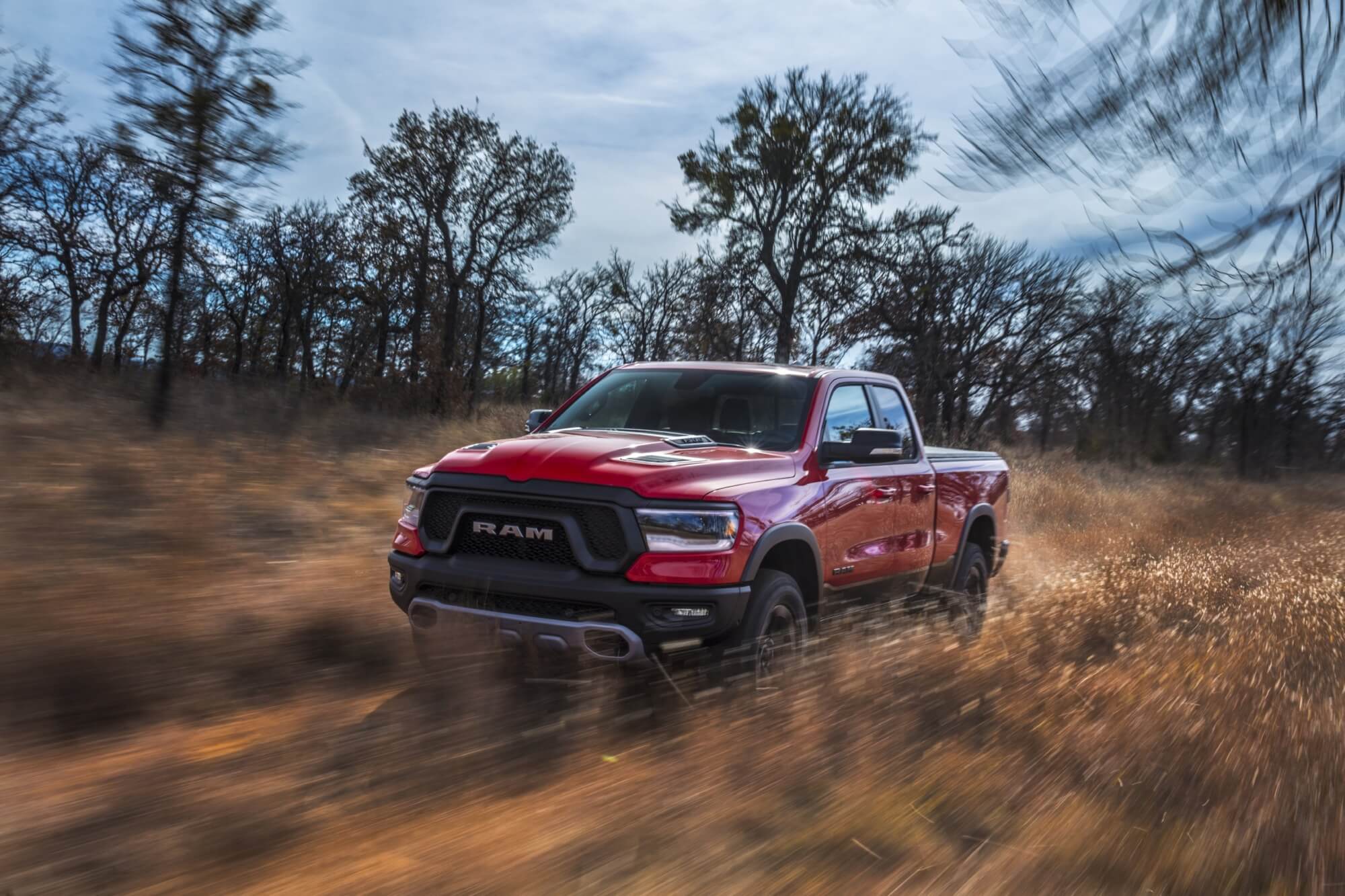
Upfront, Ram redesigned the independent front suspension with new composite upper control arms, aluminum lowers and improved geometry. The new front sway bar runs behind the suspension instead of in front like before.

Ram says that improved roll stiffness by 20 percent. Compared to the standard Ram, the Rebel uses a one-inch taller coil-over shock setup with Bilstein dampers.

In the rear, Ram uses a revised off-road focused geometry five-link design that is unique to the Rebel with 1-inch taller coil springs and Bilstein dampers with remote reservoirs. The last Rebel came standard with an adjustable air suspension, but now it’s an $1,805 option and our truck wasn’t configured this way.

Under the hood is the new third-generation 3.0-liter EcoDiesel V6 producing 260 hp at 3,600 rpm and a healthy 480 lb-ft of torque at 1,600 rpm. That’s 20 hp and 60 lb-ft more torque than the last diesel. This is a heavy revise with lots of upgrades including a new variable geometry turbo, dual loop EGR, lowered compression ratio (16:1), redesigned fuel injectors, new pistons with thinner rings and a coating on the pin and skirts to reduce losses. Those piston pins have also been offset slightly to help reduce NVH. A polymer and metal material on the bottom of the oil pan also helps silence clatter.

The new diesel stacks up well against its rivals with more torque than any of them. Ford’s 3.0-liter Power Stroke, which develops 250 hp and 440 lb-ft, is completely out-muscled by Ram. GM’s 3.0-liter Duramax cranks out more power at 277 hp but offers less torque (460 lb-ft) than the Ram.

This diesel is paired to the 8HP75 eight-speed automatic, the heavier-duty of the two 8-speed transmissions Ram uses. It has a 4.71:1 First gear and overdrives in the top two gears. Some diesel Ram 1500s offers a maximum tow capacity of 12,560 pounds. However, our Rebel was rated to tow 9,860 lbs.—still respectable. The Ram 1500 has big 14.8-inch disc brakes on the front axle and 14.9-inch discs at the rear, so that load should be easily managed.
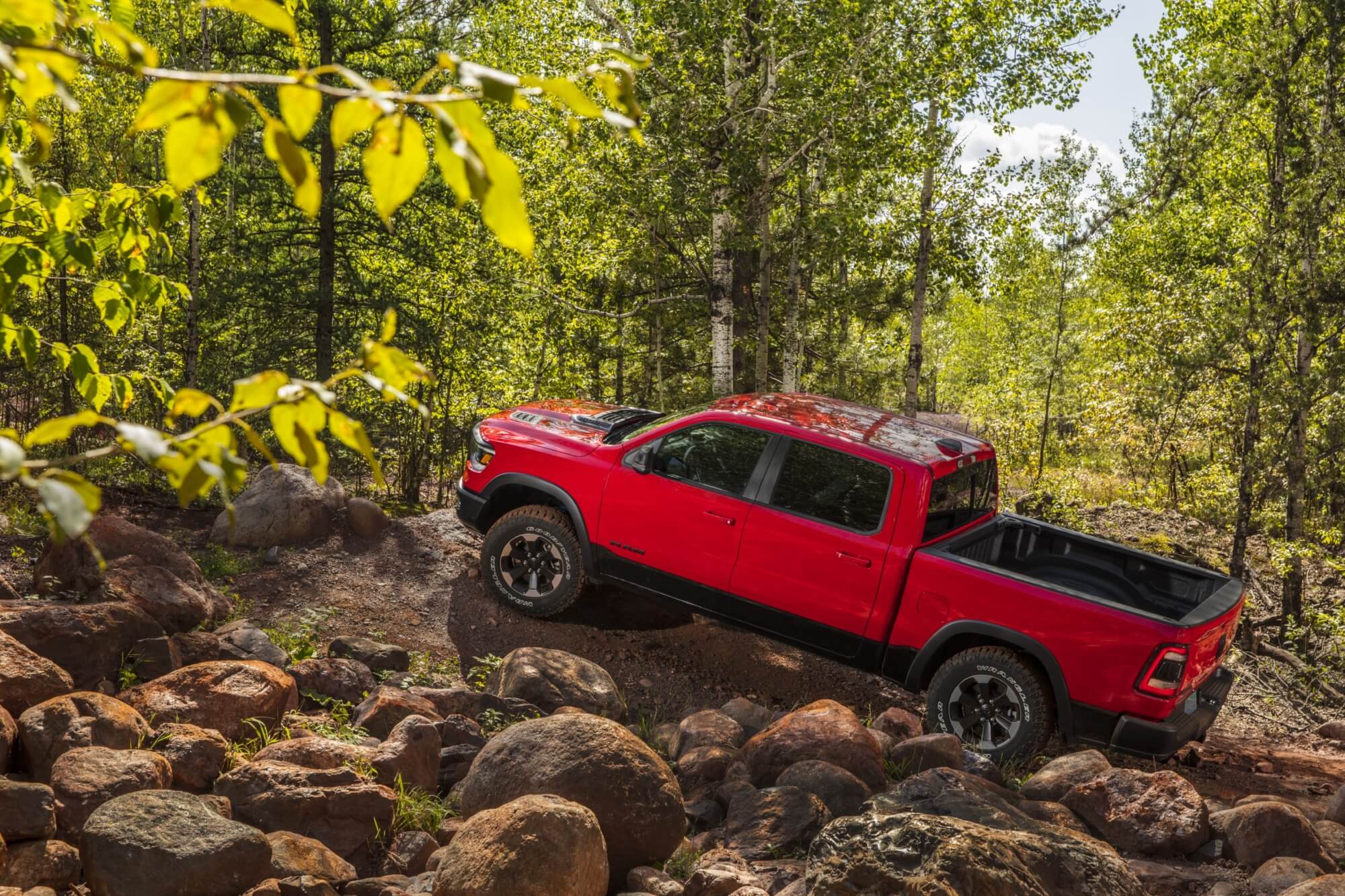
The Borg Warner 48-12 push button transfer case has upgraded internals over the previous generation for added strength and splits power down to the axles with a 2.64:1 low range. Up front is an open 8.46-inch front differential. In the rear, the Rebel uses a 9.25-inch electronic locking differential. And both are filled with deep 3.92:1 gears. But we have axle envy thanks to the 2WD V8 trucks with the Max Tow Package. Those rigs come with a Dana Super 60 rear axle with big 10-inch ring gear and 35-spline axle shafts.

At our local weigh station, the Rebel weighed 5540 lbs. and is rated to handle a payload of 1545 lbs. The GMC Sierra 1500 AT4 we tested a few months back, a gas model, weighed 5460 lbs. and offered a payload capacity of 1432 lbs.
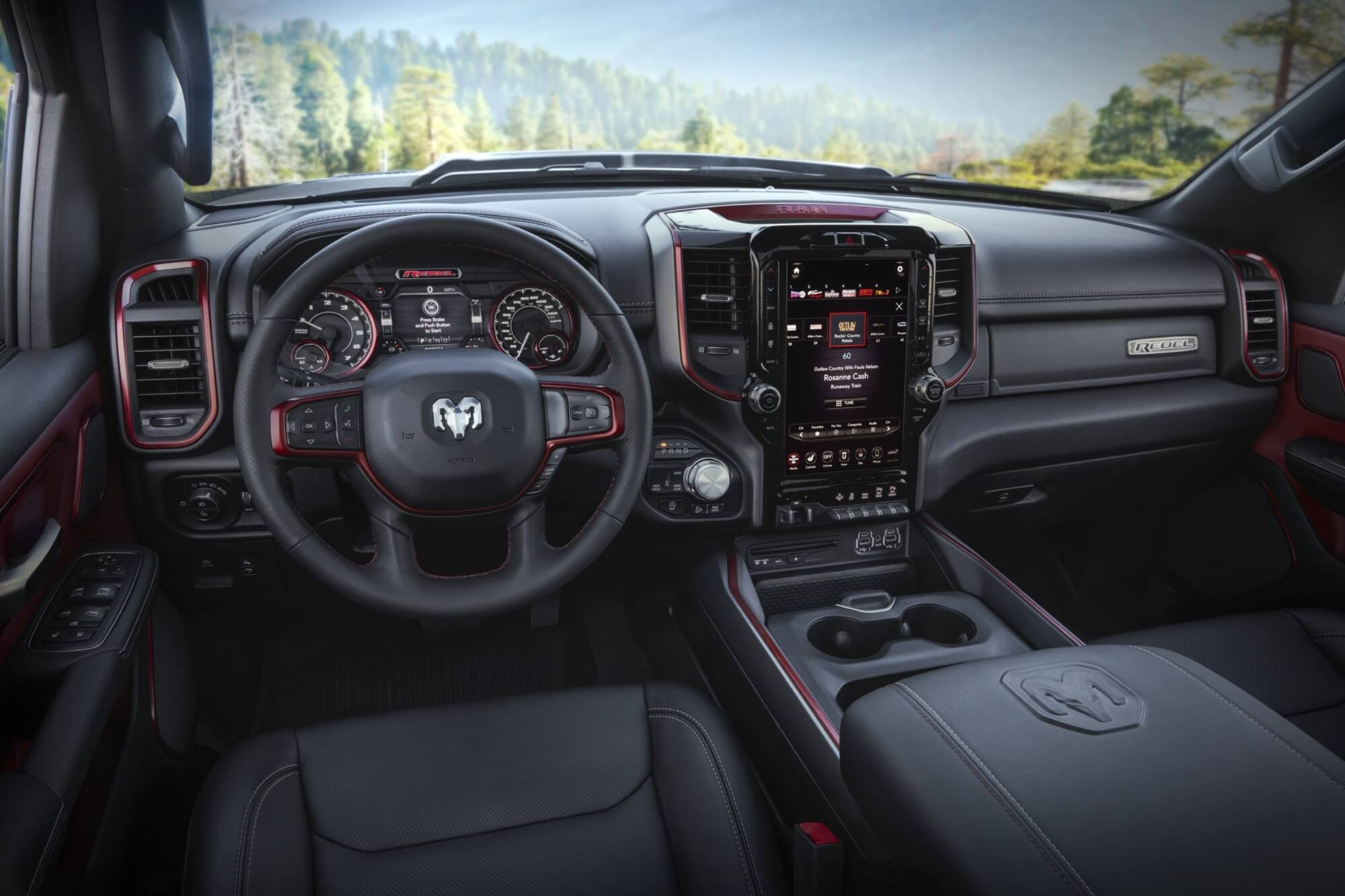
On the Street
Unlike the last Rebel which was only available in Crew cab, this new one can also be optioned with the shorter Quad Cab (like our truck) with a 140.5-inch wheelbase. And to be honest, that cab size is plenty large enough for our lives. We were able to fit adults in that back seat comfortably as well as a child’s booster seat. No, it doesn’t bring limo-levels of legroom like the Crew Cab for extended road trips, but having the trimmer wheelbase is a tradeoff we’re happy to make because it brings easier maneuverability on road and off.
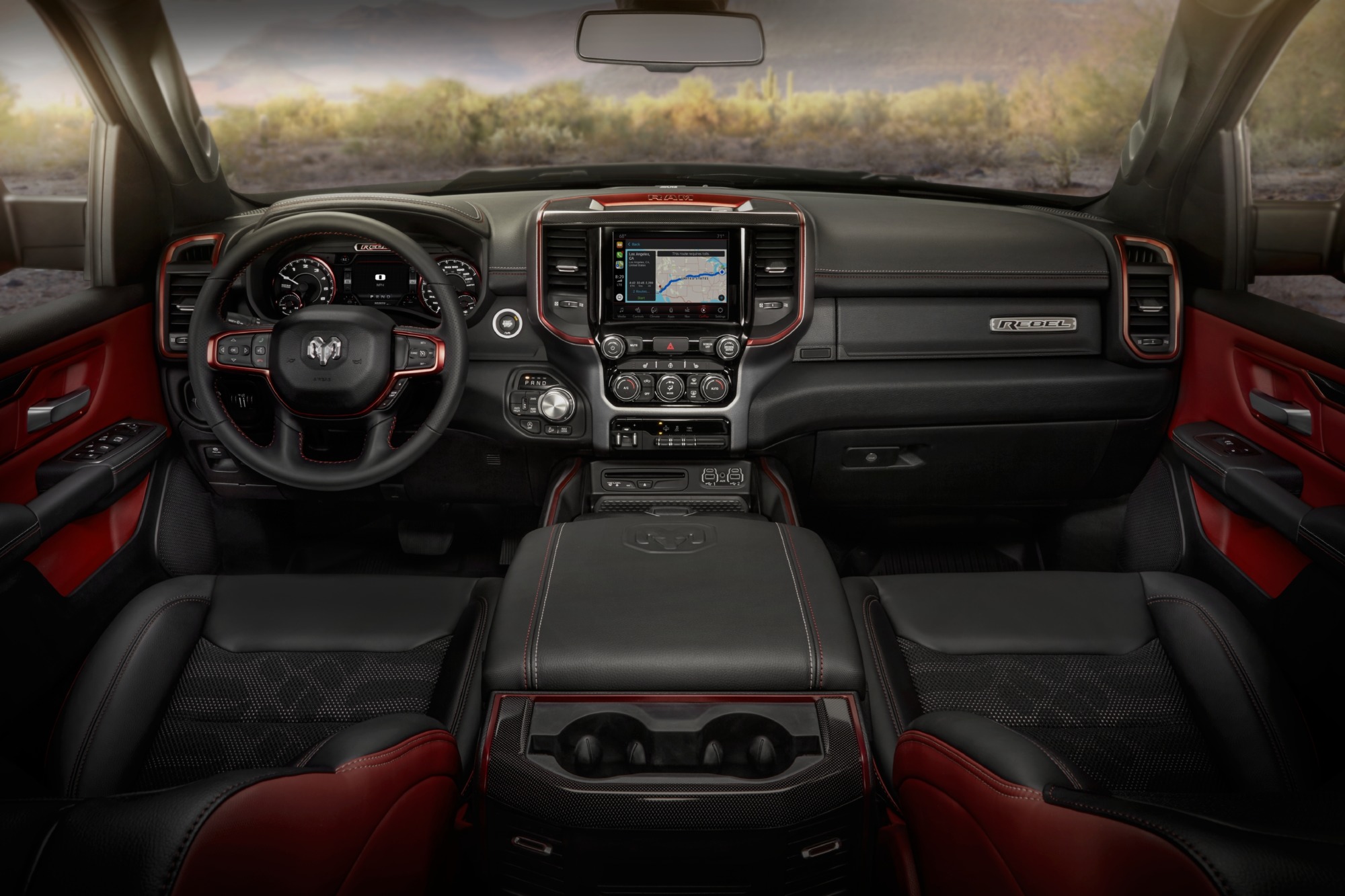
Ram really makes the Rebel’s interior unique amongst other 1500 series trucks. There’s plenty of sporty red anodized trim on the dash and a big “Rebel” badge on the glove box. The leather seats ($1,545) are equally brazen with “Rebel” outlined in white along the inside seatback bolster. It’s certainly not subtle. But it definitely feels like a specialized package, and that’s cool. The materials and switches in the Ram’s cabin are some of the best in the class. Everything feels expensive. And we particularly like the soft padding on the dash, arm rests and center console. It all makes the Rebel a truck that’s easy to live with.

Our truck had the $3,000 Rebel Level 2 equipment group which includes an 8.4-inch touchscreen, heated steering wheel and seats, Park Sense front and rear park assist, power adjustable pedals and more. The $895 Safety and Convenience Group is a bargain, and our truck had the option brining on board Adaptive Cruise Control, Advanced Brake Assist, Full Speed Forward Collision Warning, Lane Keep Assist and Automatic High Beam Control.

Squeeze the throttle of the EcoDiesel and one thing is very reminiscent of the past versions of this engine—lag. In other words, the engine doesn’t deliver an instant wollop of torque. Instead the driver has to wait for a beat or two until the turbo spools up to make boost—and torque. To be fair, this version of the EcoDiesel is less laggy than those of the past. It’s still however a compromise, especially for those that value the crisp response of a gas V8. After all, Ram’s own 5.7-liter belts out 395 hp and 410 lb-ft of torque and only costs $1,495 compared to nearly $5,000 for the diesel.

However, once that boost does build, the EcoDiesel moves out nicely thanks to a smooth and steady plateau of torque. The 8-speed snaps off quick seamless shifts too. Out on the highway, the diesel revs right at 1,800 rpm at 70 mph. A small grade will mandate a downshift and revs will rise to 2,400 rpm. The new Ecoboost isn’t as quiet or refined as GM’s 3.0-liter diesel. That said, over the subtle hum of the Goodyear Dura Tracs, you probably won’t be bothered by any diesel clatter.

The suspension is firm on the freeway with a bit of hop over certain concrete pavement expanses that are spaced just right to trip up our wheelbase. Overall, the ride is pleasant but not quite as smooth as we remember the GMC Sierra 1500 AT4 we tested. We’d like to see how that experience would improve with the air suspension. When the road begins to twist, the Rebel feels confident and poised. You never really notice any added weight on the nose of this truck from the diesel. But overall, the diesel package feels less athletic than the V8 Rebel.

At the end of our fuel economy loop, the Rebel returned just 21.5 mpg. That’s a little disappointing because its closer to the EPA city rating of 21 mpg than it is to the highway rating of 24 mpg. For comparison, that GMC AT4 we tested with the 6.2-liter V8 delivered 16.6 mpg, so an off-road package truck with a diesel does provide a fuel economy advantage.

On the Trail
The Rebel is one of those trucks that makes it easy to have fun in the dirt. There’s 9 inches under the front diff and 9.75-under the rear axle. Plus, the massive skid plate covering the front differential curves up and into the front bumper—it isn’t a fake skidplate made from plastic. It’s real metal and can take some abuse. Ram also installs plates covering the fuel tank and transfer case as well as two big tow hooks up front.

Unlike some new trucks with off-road packages, the Rebel’s locking rear differential can be engaged in 2WD. And that allows the driver to have quite a bit of fun in the desert. On the higher speed fire-type roads around the park, the Rebel’s ride feels controlled and well damped. You can even hit some mild whoops in this thing at a moderate speed. And when it bottoms that suspension, it’s not a hairy crash-down onto the bump stops. None of this means the Rebel is even close to Raptor-level performance but it’s notably better than a 4X4 pickup with a standard suspension.
In the softer sand, 2WD works okay but we did experience a little rear axle hop. Perhaps the diesel’s lag had something to do with it. That was fixed of course by shifting to 4WD High. Ram clusters the rotary shifter and the 4WD buttons together on a little pad within easy reach for the driver. And once both axles were receiving power, the sandy wash performance was excellent. We’d still like an engine that responds more quickly than this diesel, and at times the engine can cause the truck to lurch because you are constantly attempting to modulate the throttle though the soft stuff. Once that diesel is in its power and torque band, you can build some speed in the sand.

At our test hill climb, in 4WD Low with the rear diff locked, the Rebel walked its way up without much drama with 2,000 rpm showing on the tach. Part of the Rebel’s success here came from those Goodyears which have a fairly aggressive sidewall tread and could grab the sides of the ruts and pull us up. And on the way back down, the excellent Hill Descent Control system made the trip drama free. Similarly, on our twisty slow-speed mogul section, the Rebel could crawl through without touching a body panel. When the open diff caused one of the front tires to spin, the excellent traction control system managed the wheel slip elegantly. It feels like the traction control system was calibrated by Jeep engineers. Translation? It just works.

The Bottom Line
Okay, here it is. We like diesels but the gas V8 Rebel is the one to have. First, it’s $3,500 less expensive. And second? It’s just a more fun truck to drive. Yes, if we were planning to keep this truck for two decades, pile on 40,000 miles a year or tow constantly then the diesel might be the right choice. But those are very specific usage cases. As for the Rebel package itself? We’re sold. The Ram 1500 is one of our favorite trucks, so we’d spec a base Rebel, add the V8 and air suspension along with a few more options and come home with an excellent truck for less than $50,000.
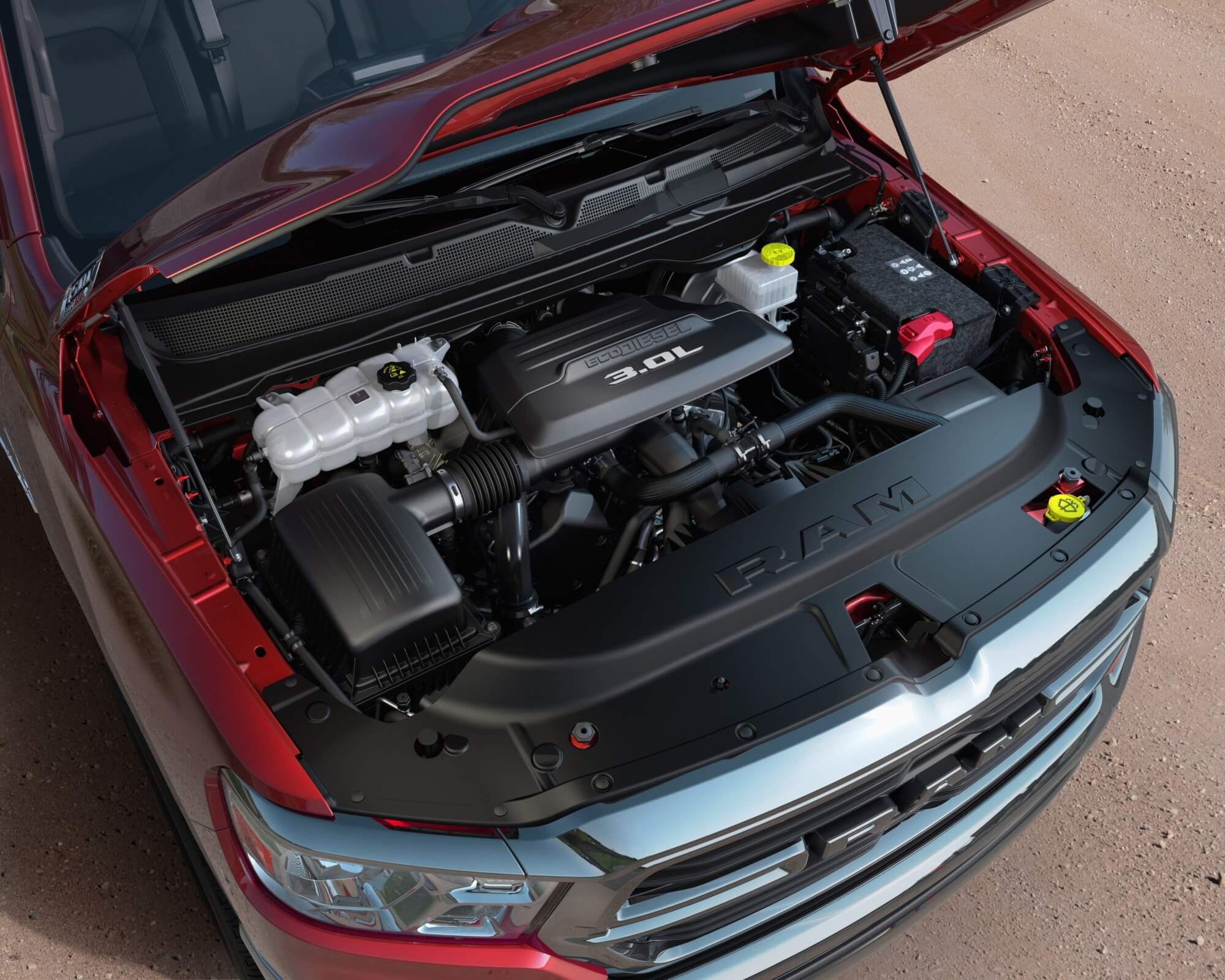
Engine
The 3.0-liter EcoDiesel V6 generates 260 hp at 3,600 rpm and 480 lb-ft of torque way down at 1,600 rpm. On paper, we should lust after this motor, but the somewhat soggy power delivery damped our enthusiasm. The package returned 21.5 mpg which was mediocre considering its city EPA rating is 21 mpg.

Front Suspension
The Rebel has an independent double wishbone front suspension using one-inch taller coils and Bilstein dampers. The open front 8.4-inch differential is protected by a huge skid-plate that we “tested” on more than one occasion.

Rear Suspension
The five-link rear suspension (also shared with the Jeep Gladiator) uses one-inch taller coils and Bilstein remote reservoir dampers. A four-corner air suspension is available for $1,805 and it’s one option we’d definitely go for.

Trail
In the realm of bone stock pickups, the Rebel can handle a mild to moderate four wheeling without a problem. The 33-inch, 275/70R18 Goodyear DuraTracs provide excellent traction and the rear locker makes a huge difference for capability. Though it was lacking a front traction diff, the tuning of the traction control systems is aggressive enough for all the trails we attempted.
Ram 1500 Parts
No matter what your hauling or conditions of the road you have to take on, you trust your vehicle to be up to the challenge. To further maximize what your truck can do for you, 4WP has and array of Ram 4×4 parts to enhance your ride.



2